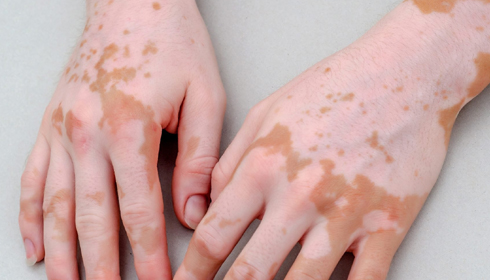
How to Detect Vitiligo and Signs to Look Out For
Vitiligo is a chronic condition where pale white patches develop on the skin due to a lack of melanin, the pigment responsible for skin colour. Although vitiligo can affect any part of the body, it most commonly appears on the face, neck, hands, and skin creases. It can also start on the lips, fingertips, and genital areas.
Vitiligo affects people of all skin types but is more noticeable in those with brown or black skin. The disorder is neither life-threatening nor contagious.
While it is considered an autoimmune disorder, it can sometimes be associated with other endocrine disorders like thyroid or adrenal gland issues.
The appearance of vitiligo can cause stress and low self-esteem. The progression of the disease is unpredictable; in some cases, the patches stop forming without treatment, while in others, pigment loss spreads and can eventually cover most of the skin. Rarely, the skin regains its color.
Signs and Symptoms
Vitiligo can manifest at any age. The signs to look out for include:
Detection of Vitiligo
A dermatologist can diagnose vitiligo through a skin examination. The doctor will check for symptoms associated with other skin conditions to rule them out, such as common eczemas or healing lesions of psoriasis. They will examine all areas of the skin to determine the type of vitiligo based on the location of the patches. On darker skin, patches are easier to detect, but on lighter skin, a Wood lamp (which emits ultraviolet light) may be used to distinguish between affected and unaffected skin. Under this light, skin with vitiligo appears different, helping to differentiate between pigment loss and colour reduction.
The appearance of lightened patches and the patient's medical history are usually sufficient for diagnosing vitiligo. However, additional tests may be recommended for further confirmation. For example, a skin biopsy can reveal whether melanocytes (pigment-producing cells) are present. The absence of melanocytes confirms a vitiligo diagnosis. A skin biopsy can also indicate whether the patient has a form of skin cancer called hypopigmented cutaneous T-cell lymphoma.
Doctors often recommend a blood test to check if vitiligo is related to an underlying autoimmune disease, such as anaemia or type 1 diabetes. Further testing may be necessary to rule out associated conditions like thyroid disease, diabetes mellitus, pernicious anaemia, Addison's disease, and alopecia areata.
Treatment Options
There is no cure for vitiligo, but treatments can halt or slow the discolouration process and restore some colour to the skin. The goal of treatment is to create an even skin tone by either restoring colour (repigmentation) or removing the remaining colour (depigmentation). Common treatments include:
Camouflage therapy: Using makeup or dyes to cover the white patches.
Repigmentation therapy: Topical corticosteroids or other medications that encourage pigment cells to return.
Light therapy: Exposing the skin to controlled ultraviolet light.
Surgery: Skin grafting or other surgical techniques to restore color.
By understanding the signs and symptoms of vitiligo and seeking appropriate medical advice, individuals can manage the condition effectively and improve their quality of life.